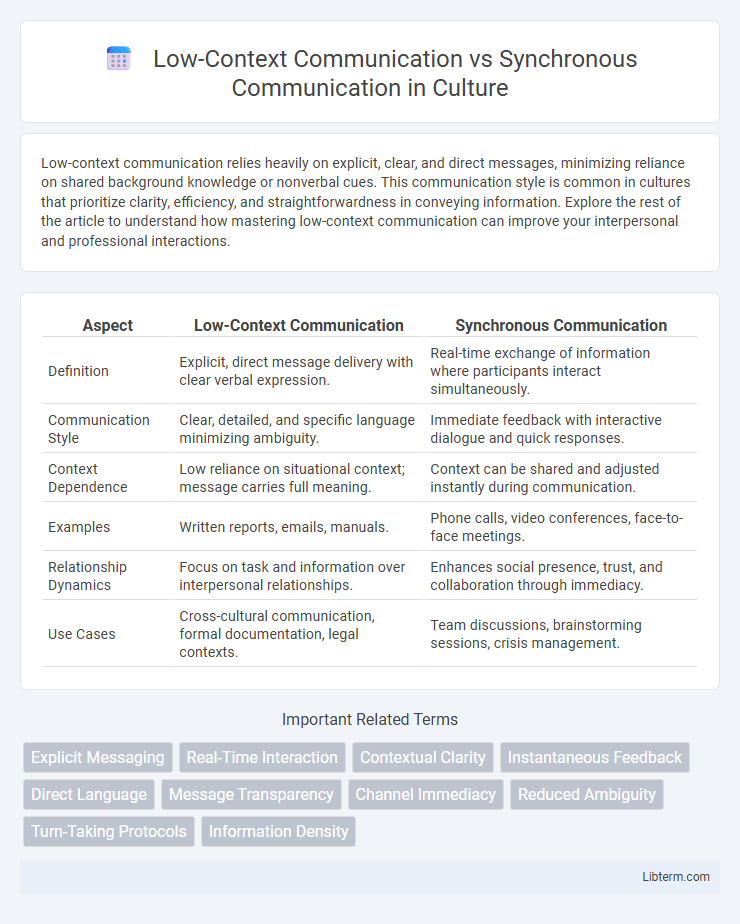Low-context communication relies heavily on explicit, clear, and direct messages, minimizing reliance on shared background knowledge or nonverbal cues. This communication style is common in cultures that prioritize clarity, efficiency, and straightforwardness in conveying information. Explore the rest of the article to understand how mastering low-context communication can improve your interpersonal and professional interactions.
Table of Comparison
| Aspect | Low-Context Communication | Synchronous Communication |
|---|---|---|
| Definition | Explicit, direct message delivery with clear verbal expression. | Real-time exchange of information where participants interact simultaneously. |
| Communication Style | Clear, detailed, and specific language minimizing ambiguity. | Immediate feedback with interactive dialogue and quick responses. |
| Context Dependence | Low reliance on situational context; message carries full meaning. | Context can be shared and adjusted instantly during communication. |
| Examples | Written reports, emails, manuals. | Phone calls, video conferences, face-to-face meetings. |
| Relationship Dynamics | Focus on task and information over interpersonal relationships. | Enhances social presence, trust, and collaboration through immediacy. |
| Use Cases | Cross-cultural communication, formal documentation, legal contexts. | Team discussions, brainstorming sessions, crisis management. |
Understanding Low-Context Communication
Low-context communication relies heavily on explicit, clear, and direct messages where most information is conveyed through words rather than context or nonverbal cues. This style is common in individualistic cultures like the United States and Germany, where clarity and precision are prioritized to avoid misunderstandings. Understanding low-context communication improves efficiency in global business interactions by ensuring messages are unambiguous and actionable.
What Is Synchronous Communication?
Synchronous communication refers to real-time interactions where participants exchange information simultaneously, such as in phone calls, video conferences, or face-to-face meetings. This communication style enables immediate feedback, clarifications, and dynamic conversations, enhancing understanding and reducing misunderstandings. It contrasts with asynchronous communication, where responses occur with time delays, often seen in emails or message boards.
Key Differences Between Low-Context and Synchronous Communication
Low-context communication relies heavily on explicit, direct messages where information is conveyed clearly without assuming shared background knowledge, while synchronous communication depends on real-time interaction, such as live conversations or video calls, allowing immediate feedback and clarification. Key differences include the reliance on context: low-context communication minimizes the need for contextual clues, whereas synchronous communication emphasizes timing and real-time exchange regardless of context level. Low-context communication is often asynchronous, prioritizing clarity and detail, whereas synchronous communication prioritizes immediacy and dynamic interaction.
Core Principles of Low-Context Communication
Low-context communication relies heavily on explicit, clear, and direct messages where meanings are conveyed primarily through words rather than context or nonverbal cues. Core principles include transparency, detailed information exchange, and unambiguous language to minimize misunderstandings in diverse or multicultural interactions. This communication style contrasts with synchronous communication, which emphasizes real-time interaction and immediate feedback, regardless of context dependency.
Benefits of Synchronous Communication
Synchronous communication provides real-time interactions that enhance immediate feedback and clarify misunderstandings quickly, promoting effective collaboration. This mode supports dynamic discussions and decision-making processes, which are essential in fast-paced work environments. Teams using synchronous communication benefit from increased engagement and stronger interpersonal connections, leading to improved productivity.
Challenges in Low-Context Communication
Low-context communication often faces challenges such as misinterpretation due to its reliance on explicit messages rather than shared context, leading to frequent clarification needs and possible information overload. This approach can slow down decision-making processes as participants must articulate detailed instructions that might otherwise be inferred in high-context situations. Additionally, cultural differences may amplify misunderstandings, as low-context communication assumes a uniform understanding of explicit cues that do not account for nuanced social and cultural dynamics.
Synchronous Communication in the Digital Age
Synchronous communication in the digital age enables real-time interaction through tools like video calls, instant messaging, and live webinars, facilitating immediate feedback and collaboration. This mode of communication is essential for remote teams, enhancing productivity and maintaining team cohesion despite geographical distances. Platforms such as Zoom, Microsoft Teams, and Slack optimize synchronous communication by integrating multimedia capabilities and seamless user interfaces.
Practical Examples: Low-Context vs. Synchronous Communication
Low-context communication thrives in email exchanges where explicit details minimize misunderstandings, while synchronous communication excels in video calls enabling real-time feedback and dynamic interaction. In project meetings, low-context emails ensure clarity by documenting tasks comprehensively, whereas synchronous discussions allow immediate problem-solving and collaborative brainstorming. Customer support benefits from low-context FAQs for self-service, contrasted with synchronous chatbots offering instant, personalized assistance.
Choosing the Right Communication Style for Your Team
Choosing the right communication style for your team hinges on understanding the differences between low-context communication and synchronous communication. Low-context communication relies on explicit, clear messages that minimize assumptions, making it ideal for diverse teams or remote work settings where clarity is paramount. Synchronous communication, characterized by real-time interactions such as video calls or instant messaging, fosters immediate feedback and collaboration, boosting team alignment and responsiveness in fast-paced environments.
Cultural Impacts on Communication Styles
Low-context communication relies on explicit, clear messages where meaning is conveyed primarily through words, common in cultures like the United States and Germany, emphasizing directness and clarity. Synchronous communication, characterized by real-time interaction such as face-to-face conversations or video calls, is influenced by cultural norms surrounding immediacy and feedback expectations, prevalent in high-context cultures like Japan and China. Cultural impacts shape communication styles by determining preferences for explicitness versus context reliance and the value placed on immediate response, affecting how messages are interpreted and exchanged.
Low-Context Communication Infographic

 libterm.com
libterm.com